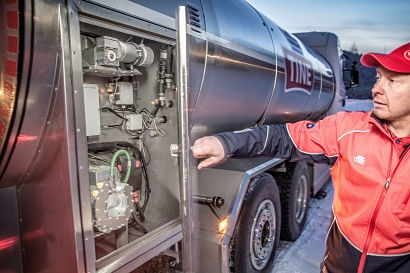
Lots of carbon dioxide is emitted unnecessarily every time tankers arrive at farms to collect milk, because the trucks use their oversized diesel engines to drive the pump that fills the tank. Every tanker pumps milk for about 1000 hours per year, which costs dairies a lot of money. Installing a battery-powered electric motor reduces both the amount of diesel used and wear and tear on the diesel engine. Semcon, Tine and Enova are working in partnership on this project and Tine, a Norwegian company responsible for most transportation of milk in Norway, is planning to install the new pumps in all 250 of its vehicles.
“One of the strengths of the Semcon solution is that dairies do not need to buy new trucks – the new technology can be implemented in vehicles they already have” said Hans Peter Havdal, head of division at Semcon.
Frode Eggan at Tine added that the company will reduce its diesel consumption by 1.25 million litres per year when all its milk pumps run on electricity. This means that CO2 emissions will be reduced by 3200 tonnes a year. The investment in the climate will pay off financially as well as the costs will be reduced by several million kroner.
More than 120 million litres of diesel a year could be saved if all EU dairies were to adopt this solution. Moreover, the technology can be transferred to other areas as well.
“We have focused on milk here, but really the technology could be applied to anything that is pumped into tankers – grain or pellets, liquids like beer” said Havdal. “Incredible amounts of diesel could be saved”
The battery for the electric motor is charged while the vehicle is in motion, like an ordinary car battery. The batteries provide enough energy for defrosters, lights, windscreen wipers, etc. – elements that help to guarantee the comfort and safety of the driver. There is hardly any noise during electric pumping, which means that disruptive noise at farms can be reduced significantly while milk is being collected.
For additional information:

